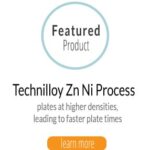There are a variety of copper plating technologies. These include acid copper, electroless copper, alkaline non-cyanide copper and alkaline cyanide copper. With the EPA’s Common Sense Initiative, plating facilities are moving away from the cyanide copper processes. The Common Sense Initiative impacts the automotive, iron and steel, computers and electronics, printing, petroleum refining, and metal finishing industries. Its objective is to reduce or prevent pollution, and the plan assigned a high priority to reducing or eliminating emissions of hexavalent chrome, chlorinated solvents, cadmium … [Read more...]
Effective Manufacturing Parts Cleaning
Parts washing and coating pretreatment is an integral part of many manufacturing operations across the U.S. today. Typically if the part is going to be welded, coated, assembled, or shipped "as is," the greases, lubricants, coolants, and oils from the previous step must be removed to ensure effective future process success. Sometimes the pretreatment step is an afterthought, or an effective full assessment has never been performed to determine what is the best pretreatment chemistry for your process. How do you choose the best pretreatment chemistry? Many times the existing cleaning … [Read more...]
Some Electrical Troubleshooting Notes
When trying to figure out what is causing a particularly stubborn plating problem, and checking out the chemistry seems fine, you know that you sometimes have to check out the electrical area of the process. These are a few things you can do with a VOM (volt-ohm meter). First of all, be sure you have a good VOM that has built in capacitance and not a cheap “battery tester." Checking for AC Ripple from Rectifier If the rectifier has recently dropped a diode or has degraded filter capacitors, it may not be filtering out the unwanted AC current properly. When this happens, the AC ripple is … [Read more...]
Watts Nickel Bath: Basis for Modern Nickel Plating
When looking at the chemistry of the Modern Nickel Plating solution, you have to go back to the early 1900’s; 1916, to be more precise. Watts began plating nickel with nickel sulfate, nickel chloride and boric acid. These components are the basis of all modern bright, semi-bright, microporous and high-sulfur formulations used today. While the combination is always the same, the amounts differ some by bath type and manufacture. To compare the original formulation to the bright nickel levels, here are the typical levels: 1916 2013 Range Nickel … [Read more...]
Prosclean Phos Strip L
PHOS STRIP L is an alkaline liquid product used to remove heavy zinc phosphate coatings from ferrous substrates. PHOS STRIP L contains a surfactant package that will generate a foam blanket during the stripping process to keep fumes and mist escaping from the process tank to a minimum. Due to the high alkalinity content of PHOS STRIP L, it can also be used for alkaline pickling of steel to remove rust and scale avoiding the use of corrosive liquid acids. … [Read more...]
Technibrite SN 200
TECHNIBRITE SN 200 is an easy to use bright acid tin process that produces exceptional brightness and leveling from a standard sulfate acid tin electrolyte while maintaining exceptional solderability. After the initial make up of the plating solution using TECHNIBRITE SN 200 MU and SN 200 MT, the deposit quality is maintained with TECHNIBRITE SN 200 MT additive. This maintenance additive can be constantly metered into the plating solution using an ampere hour brightener feeder. The TECHNIBRITE SN 200 process is unique in that the brightener system is stable upon standing. Due to the stability … [Read more...]
Techniclean N-326 L
TECHNICLEAN N-326 L is a medium alkaline liquid cleaner that can be used as a soak and/or electro cleaner for both ferrous and non-ferrous metals. This product is ideal for job shop applications where different metal substrates are processed though one plating line. The specially formulated surfactant package of TECHNICLEAN N-326 L provides good cleaning and free rinsing eliminating staining of the substrate. TECHNICLEAN N-326 L is an excellent cathodic activator of nickel deposits prior to chrome plating. … [Read more...]
Functional Zinc Processes
Zinc is one of the most widely used functional sacrificial coatings to inhibit corrosion of ferrous metals. Over the years a variety of Zinc plating and post treatment chemistries (chromates –hexavalent and trivalent-- and seals) have been developed to improve the aesthetics and functionality of zinc coatings. Over the years there have been three types of zinc processes: Cyanide based chemistry – seldom used today because of safety issues, waste treatment and disposal cost—but still it is needed in some applications. These processes were very forgiving and easy to control. Environmental … [Read more...]
